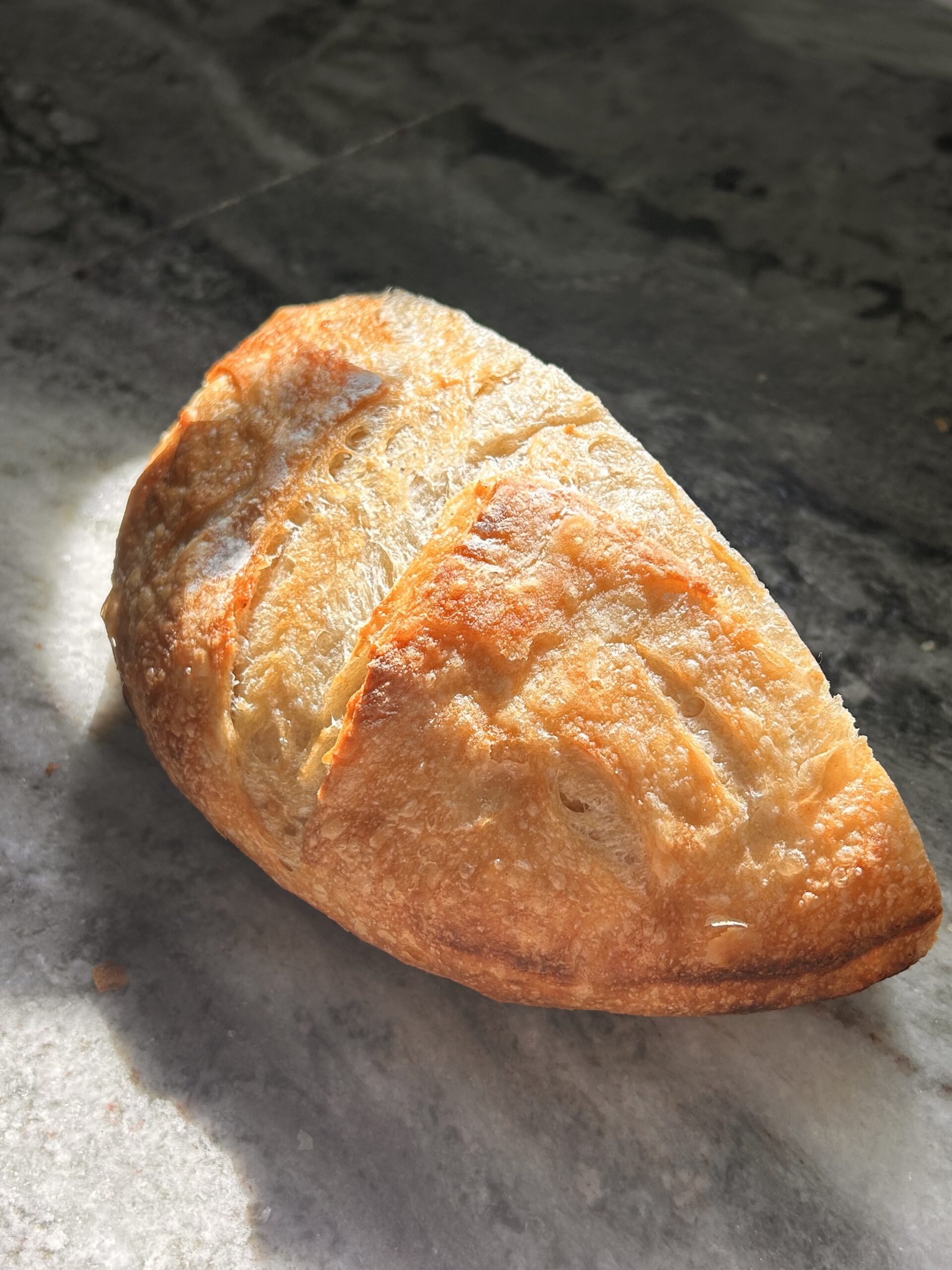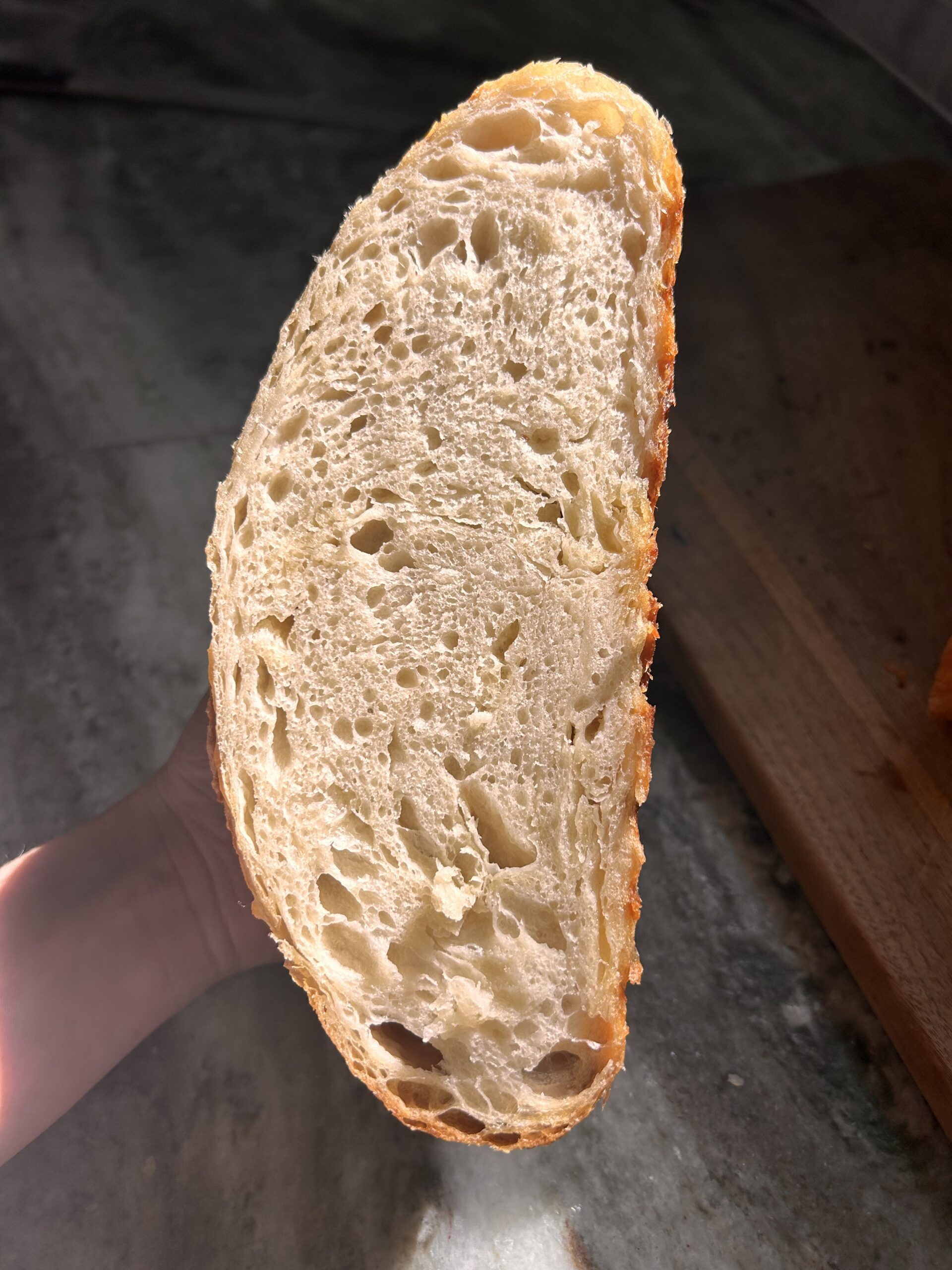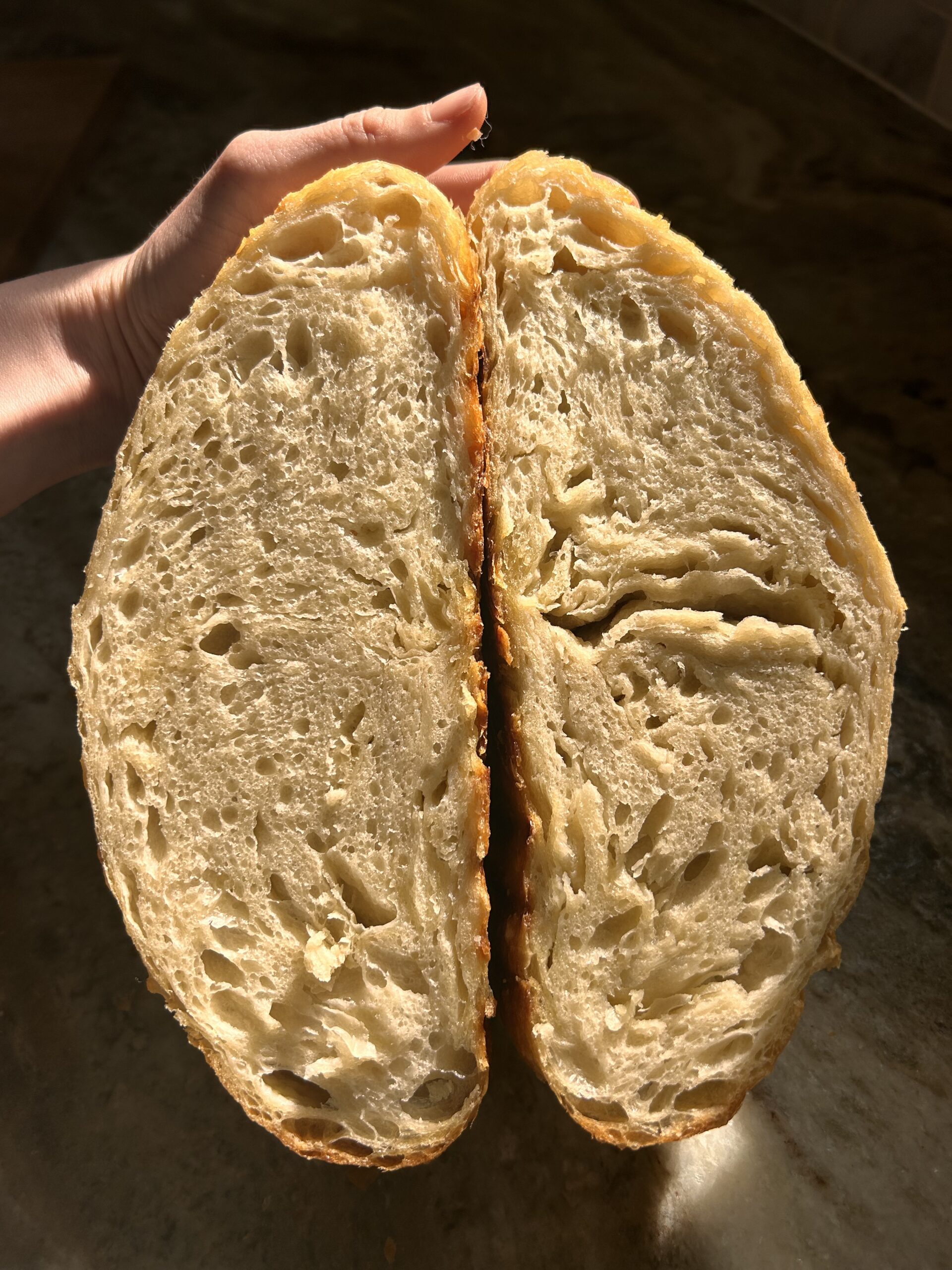Buttery Hands are Inevitable
I first saw the idea trending on social media – bakers grating frozen butter into dough to get flaky layers without the drama of actual lamination. After a few messy experiments (think butter bits everywhere), I can confidently say it’s worth the effort. In this post, I’ll walk you through two methods to make croissant-style bread: one with sourdough starter for those who love that tangy depth and have a bit of patience, and one with instant yeast for a quicker, more spontaneous bake. Both versions are delicious, indulgent, and easier than traditional croissants, which I have made so trust on that!
This version uses a sourdough starter (natural levain) for fermentation. It takes longer than the yeast method, but rewards you with rich flavor and a chewier crumb. Plan for an unrushed day or start the night before. The key here is cool fermentation: we’ll keep the dough around 70°F (21°C) so the grated butter stays firm, creating distinct layers. Remember to feed your starter ahead of time so it’s bubbly and active when you mix the dough!

Ingredients
- 544g bread flour
120g active sourdough starter (about 22% of the flour weight; ideally 100% hydration¹, fed and bubbly)
370g water (room temperature; use cooler water if your kitchen is warm)
15g salt (about 2¾ teaspoons)
113g unsalted butter, cold (1 stick; freeze for 20-30 minutes and then grate for layering)
*¹ If your starter is 100% hydration, 120g starter contains ~60g flour + 60g water, which is accounted for in this formula.
Instructions
1. Mix the Dough: In a large bowl, stir together the 370g water and 120g starter until the starter starts to disperse. Add the 544g flour and 15g salt. Mix with your hands or a dough spatula until there are no dry bits of flour. The dough will be shaggy and slightly sticky – that’s perfect. Scrape down the sides of the bowl, cover it with a towel, and let the dough rest for about 30 minutes. (This rest, called autolyse or “hydration period,” allows the flour to absorb water and gluten to start developing on its own.)
2. Stretch and Fold – Phase 1: After the rest, perform a stretch and fold: With damp hands, scoop under one side of the dough, stretch it up gently without tearing, and fold it over to the opposite side. Give the bowl a quarter turn and repeat with another portion of dough. Do this a few times around the bowl. This strengthens the gluten network. Cover again and wait 20–30 minutes. (No butter added yet – we’re building a bit of strength first.)
3. Incorporate Butter with Folds: Now for the fun part – layering in that butter. Sprinkle half of the grated cold butter evenly over the dough’s surface. Perform another round of stretch-and-fold: reach under, stretch the dough and fold it over itself, trying to keep the butter shreds in between layers of dough. Turn the bowl and repeat until you’ve folded the dough over itself several times (about 4–6 folds). The butter may try to escape; just tuck it back in. Cover and rest 20–30 minutes. The dough will feel softer and a bit greasy – don’t worry, those butter bits are going to create flaky layers as we continue.
4. Second Butter Fold: Add the remaining grated butter over the dough and do one more round of gentle stretches and folds to incorporate. By now, the dough will be smoother and you’ll start seeing streaks of butter throughout – messy, buttery layers = future flaky goodness. Cover the bowl again.
5. Bulk Fermentation: Let the butter-laden dough ferment at room temperature (~70–72°F / 21–22°C) until it rises and looks puffed and airy. Aim for about a 50–70% increase in volume (it may not fully double due to the weight of the butter, and that’s okay). This bulk rise can take about 6–8 hours at moderate room temp with a strong starter. (For example, if you mixed in the morning, the dough might be ready by late afternoon or evening. Cooler temps or a less active starter could stretch it longer.) You should see small bubbles on the surface and dough that jiggles if you gently shake the bowl. Tip: If your room is warmer than 75°F, consider placing the dough in a cooler spot or even the fridge for parts of the bulk rise to keep that butter firm. Temperature control is crucial here – warm dough will cause the butter to melt into it (losing the layering effect).
6. Shape the Loaf: When the dough has risen, it’s time to shape. Prepare a proofing basket or medium bowl lined with a lightly floured cloth. Lightly flour your countertop and gently turn out the dough. It will be soft, so handle with care to preserve those layers. If it’s very sticky, sprinkle a tiny bit of flour on top. Preshape by folding the edges toward the center: imagine folding the dough like an envelope – bring the top edge down to the center, the bottom up, then the sides in, forming a loose round. Flip it seam-side down and let it rest on the counter for 15–20 minutes to relax (this is a bench rest).
After resting, do the final shape. For a round loaf (boule), flip the dough seam-side up again. Gently stretch the top and bottom edges and fold them inward one more time, then do the same with the left and right edges, like closing a bundle. Cup your hands around the dough and flip it seam-side down. Tension the surface by gently dragging the dough toward you on the counter a couple of inches – this tightens the skin of the loaf. You should have a neat round. Carefully lift it into your prepared basket seam-side up (so the smooth side will be on top when you bake).
(Shaping tip: Avoid over-handling – you don’t want to smear the butter too much. If at any point the butter is oozing or the dough is hard to handle, pop it in the fridge for 10 minutes to firm up before continuing.)
7. Final Proof (Room Temperature or Cold): Now the dough needs a final rise (proof) before baking. You have two options:
Overnight Cold Proof (Recommended): Cover the shaped dough loosely with plastic wrap or place the basket in a large plastic bag. Refrigerate overnight (8–12 hours). The dough will continue to ferment slowly in the cold, developing fantastic flavor. An added bonus: cold dough is much easier to score and tends to hold the butter layers distinct during bake. (If refrigerating longer than 12 hours, the dough could overproof – if in doubt, bake by the 12-hour mark.)
Same-Day Bake: If you want to bake it the same day, cover the loaf and let it sit at room temperature for about 1 to 2 hours. It likely won’t double (sourdough often rises ~30-50% in the final proof), but it should perk up a bit – when you poke the dough gently, it should spring back slowly. Important: Because the butter in the dough is now soft, chill the dough for 20-30 minutes before baking (you can stick it in the fridge or freezer while the oven preheats). This ensures the butter is firm for baking, which leads to more pronounced flaky layers and makes scoring easier.
8. Bake in Dutch Oven: Place your Dutch oven (with its lid) in the oven and preheat to 500°F (260°C). Give it a good 30 minutes to heat up so it’s blazing hot – this heat burst helps the bread rise. When ready to bake, cut a sheet of parchment paper large enough to hold your loaf. Gently invert your proofed dough onto the parchment (so now the smooth side is up and the seam is on the bottom). Use a sharp blade or bread lame to score the top: a simple one-lengthwise slash (~½ inch deep) or a few slashes in a pattern. Carefully remove the hot Dutch oven and transfer the parchment with the dough into it. Cover with the lid.
Bake at 500°F (260°C) for 20 minutes with the lid on. This traps steam from the dough, puffing up those layers. Then, remove the lid (watch out for a burst of steam!) and lower the oven temperature to 450°F (232°C). Bake for an additional 20–25 minutes until the loaf is deep golden brown. The crust will be richly colored and you might see some buttery sizzle around the edges – that’s normal (and makes the crust deliciously crisp). If you’re unsure about doneness, you can check that the internal temperature is around 205°F (96°C) or that the loaf sounds hollow when tapped on the bottom.
Once baked, carefully remove the loaf from the Dutch oven and let it cool completely on a rack (at least 1–2 hours) before slicing. (I know, waiting is hard! But slicing too soon can squish the layers and make the crumb gummy.) As it cools, the kitchen will smell like a French boulangerie – buttery, toasty, irresistible.
9. Enjoy: When fully cooled, slice with a sharp bread knife to reveal the beautiful layered crumb. You’ll notice a lightly flaky crust and a soft, buttery interior that peels apart like a croissant. Serve it as is, or spread a little jam, butter (because why not more butter), or enjoy with your morning coffee.

Iski Note
- If Butter Leaks During Bake: Don’t panic! A little butter might pool at the edges of the loaf while baking, especially if the dough was slightly underproofed or a big chunk of butter was near the surface. This can actually fry the bottom crust into a delicious almost-browned-butter flavor. If you see excessive smoking or burning butter, you can place a baking sheet on the rack below to catch drips. In my experience, using the right temp and proofing adequately minimizes leaks. And the bits that do leak? They contribute to that crispy, fried bottom crust that everyone fights over.


Why this recipe hits
This croissant bread is decadent on its own, but it also makes amazing French toast! Also, customize it as much as you’d like! Chocolate croissant bread, almond croissant bread, anything you’d like!
This loaf makes a great gift!

4 Responses
I cannot wait to try this recipe. I’m wondering if I can use milk instead of water?
Never tried it before, I imagine it’ll change the dough to be more brioche like! I say go for it for fun/experimental purposes
Where do you throwin the ice cubes?
I use water or ice cubes to create steam if I do an open bake or use a dutch oven as soon as I start baking the bread ! i put it under my parchment paper if i use the dutch oven, open bakes i put a pan of water in the oven to create steam and keep it going the entire time.